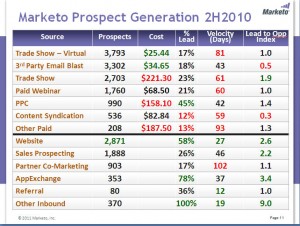Update: All MarketingSherpa newsletter articles are now permanently open access.
Several weeks ago I had the chance to speak with Jon Miller, Marketo‘s Vice President, Marketing, and co-founder of the company. Our talk was extensive and covered Marketo’s entire marketing process and philosophy, and the main result was a MarketingSherpa B2B newsletter case study (members library).
Even though the story was extremely in-depth and revealing in covering the marketing automation company’s practices — so much so that when my editor tweeted the story he wrote, “#B2B Marketing Strategy: Revenue-oriented approach leads to 700% two-year growth http://j.mp/lWT7PS @jonmiller2 opens up the kimono” — not everything Jon and I discussed made it into the case study.
One result of the extra material I have on hand was a popular MarketingExperiments blog post on testing form field length, and a second result is today’s SherpaBlog post going into more detail about Marketo’s cost-per-lead across its prospect generation efforts.
It’s a prospect, not a lead
Even though “lead generation” and “cost-per-lead” are something of industry terms of art, Jon explained to me that Marketo has a rigorous naming system for its eight-stage buying cycle, or what it calls a “revenue cycle:”
1. Awareness
2. Names
3. Engaged
4. Prospect
5. Lead
6. Sales lead
7. Opportunity
8. Customer
For someone to move from “engaged” to “prospect,” they must visit Marketo’s website and either fill out a form or download content. At this point they undergo demographic lead scoring. Using this scoring, Jon says a prospect is, “the right kind of person at the right company.”
Marketo defines a “lead” how most companies might identify a marketing-qualified lead, so at Marketo “prospects” are in effect its traditionally defined leads. Confused yet?
This chart takes a look at Marketo’s prospect generation metrics for the last two quarters of 2010. You will notice above the line are efforts Jon pays some marginal cost for and each includes its cost-per-lead. Below the line are Marketo’s non-marginal-cost inbound marketing efforts.

Click to enlarge
Virtual beats traditional in trade shows
Virtual trade shows stand out in this list because they create the most prospects at the lowest cost-per-lead. In fact, the figure on the far right of this chart, lead-to-opportunity index, is calibrated to the virtual trade show statistics.
“For us, virtual trade shows work great,” Jon says. “You get the database really cheap and they become leads, too.”
He adds that pay-per-click advertising has a fairly high cost-per-lead, but they also convert to opportunities at a high level at the highest velocity (in terms of least days), and they almost double the closest conversion-to-lead figure. It is worth it to Marketo to spend the extra cost-per-lead money on PPC ads.
The worst overall performing tactic on the chart is the traditional trade show. These events have the highest cost-per-lead by a long shot and don’t offer a strong conversion-to-lead number, and the strong lead-to-opportunity conversion ratio doesn’t offset the weaker stats.
Based on this information from last year, Jon told me he plans on cutting back on traditional trade shows this year and is spending that money on traveling to captive event road shows.
Inbound rising …
One very interesting aspect of Marketo’s prospect generation chart is the performance of its non-marginal cost inbound marketing tactics. Across the board they meet, and often greatly exceed, the baseline lead-to-opportunity index. Velocity and conversion-to-lead also compare very favorably for most tactics.
And the cost-per-lead for these inbound efforts? Effectively zero.
What lead generation tactics do you find successful? Do you track the success rate and bottom-line impact of your inbound efforts? Let us, and your peers, know what you think in the comments section.
Related resources
Lead Gen Overhaul: 4 Strategies to Boost Response Rates, Reduce Cost-per-Lead
Custom Landing Pages for PPC: 4 Steps to 88% More Leads, Lower Costs
Lead Generation: How to get funding to improve your lead gen
Social Media Marketing: You value (and earn ROI on) what you pay for
Lead Marketing: Cost-per-lead and lead nurturing ROI
Search Engine Marketing: Finding appeal for your PPC Ads
Social Media Marketing Research: Rolling up my sleeves and getting social
 Lead nurturing by telephone is the more time-intensive effort. Phone calls also offer the opportunity to create a strong connection with the lead. It’s relatively easy to set up an automatic email send with a link to an interesting industry article, or with a white paper attached as a PDF. A phone call provides a great opportunity to discover more information about your lead’s buying cycle and what content they find most valuable.
Lead nurturing by telephone is the more time-intensive effort. Phone calls also offer the opportunity to create a strong connection with the lead. It’s relatively easy to set up an automatic email send with a link to an interesting industry article, or with a white paper attached as a PDF. A phone call provides a great opportunity to discover more information about your lead’s buying cycle and what content they find most valuable.








